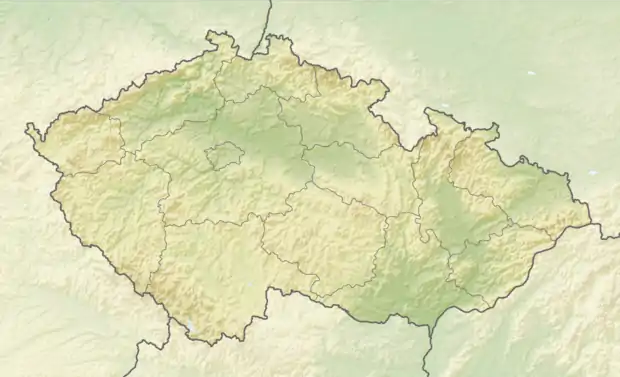Jirkov
Jirkov (Czech pronunciation: [ˈjɪrkof]; German: Görkau) is a town in Chomutov District in the Ústí nad Labem Region of the Czech Republic. It has about 19,000 inhabitants.
Jirkov | |
|---|---|
Town | |
 Church of Saint Giles and the Town Tower | |
 Flag  Coat of arms | |
 Jirkov Location in the Czech Republic | |
| Coordinates: 50°30′1″N 13°26′31″E | |
| Country | |
| Region | Ústí nad Labem |
| District | Chomutov |
| First mentioned | 1352 |
| Government | |
| • Mayor | Darina Kováčová |
| Area | |
| • Total | 17.11 km2 (6.61 sq mi) |
| Elevation | 305 m (1,001 ft) |
| Population (2020-01-01[1]) | |
| • Total | 19,241 |
| • Density | 1,100/km2 (2,900/sq mi) |
| Time zone | UTC+1 (CET) |
| • Summer (DST) | UTC+2 (CEST) |
| Postal code | 431 11 |
| Website | www |
Geography
Jirkov is situated between Most and Chomutov, on the Chomutov – Ústí nad Labem railway line. Although geographically close to the German border, the presence of hills along the border hinders land travel to Germany.
History
Until 1918, the town was part of the Austrian monarchy (Austria side after the compromise of 1867), in the Komotau (Chomutov) district, one of the 94 Bezirkshauptmannschaften in Bohemia.[2] From 1938 to 1945 it was one of the municipalities in Sudetenland. After the surrender of Germany, nearly all of the town's hitherto inhabitants were expelled, and new Czech settlers found a new home in the depopulated city.
Sights
Červený Hrádek Castle
Červený Hrádek (formerly Borek Castle) was founded by the Kraa family prior to 1415. The castle was sacked by the Hussites in 1421 and, after renovation later in the 15th century, the façade was painted red – hence the name Červený Hrádek (or Red Castle). In 1687 and 1688, the baroque sculptor Jan Brokoff carved statues, fountains and other works at the castle. His son Ferdinand Maxmilian Brokoff, also a sculptor, was born there. The last aristocratic family to own the castle were the Hohenlohe-Langeburgs, Accessible areas of the castle include the castle's chapel, the hall of mirrors, the gallery and the study of Max Hohenlohe, the last owner.
In August 1938, the British mediator in the dispute between Germany and Czechoslovakia over the Sudetenland, Lord Runciman, met the leader of the Sudeten German Party (SdP), Konrad Henlein, at the castle.[3]
Long cellar
Long cellar was built in year 1555. People built the cellar for 40 years. It had 150 counters. Its second name is Sand cellar. Long cellar served to the brewery and to a beer storage. Thanks to this, the beer was better. Beer was brewed in Jirkov from year 1443. People brewed beer in the 16th and 17th centuries. A brewery was built near Long cellar in year 1841; thanks to this, Long cellar lost importance.
Since 2006 the town cellars are accessible for visitors. Since 2011 the town cellars were declares cultural monument.[4]
St. Giles Church
The oldest monument in Jirkov, St. Giles Church, was originated in year 1300. It was rebuilt and improved in year 1538 again.
Sport
Every year the town organizes the Jirkov Crossmarathon.
Notable people
- Ferdinand Brokoff (1688–1731), sculptor
- David Kämpf (born 1995), ice hockey player
Twin towns – sister cities
 Bátonyterenye, Hungary
Bátonyterenye, Hungary Brand-Erbisdorf, Germany
Brand-Erbisdorf, Germany Šentjur, Slovenia
Šentjur, Slovenia
References
- "Population of Municipalities – 1 January 2020". Czech Statistical Office. 2020-04-30.
- Die postalischen Abstempelungen auf den österreichischen Postwertzeichen-Ausgaben 1867, 1883 und 1890, Wilhelm Klein, 1967
- Vyšný, Paul, The Runciman Mission to Czechoslovakia, 1938: Prelude to Munich, Palgrave Macmillan, Basingstoke, Hampshire, 2003, ISBN 0-333-73136-0, pp. 215-7.
- "Městské sklepy" (in Czech). Město Jirkov. Retrieved 2020-08-14.
- "Partnerská města" (in Czech). Město Jirkov. Retrieved 2020-08-14.
External links
 Media related to Jirkov at Wikimedia Commons
Media related to Jirkov at Wikimedia Commons
